Engineering:Rail system (firearms)
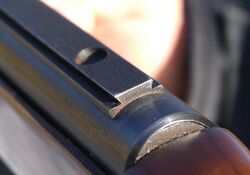
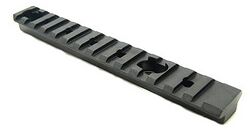
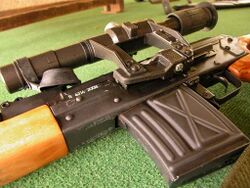
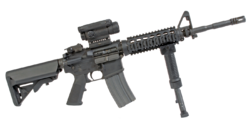
Rail systems on firearms are straight mounting brackets (usually made of strips of metal or polymer) on the gun's receiver, handguard or fore-end stock to allow sliding/variable-position attachment of optical sights and accessories such as tactical lights, laser sights, vertical/angled foregrips and bipods. An example of just a few options that may be used depending on a mission's need for the M4 is SOPMOD, amongst many other accessories like sling attachment points (which may be ether ring, loop and/or quick detach mounts using push button style hardware) to name just a few of the many options. An advantage with the multiple rail slots is the moveable positions to adjust for optimal placement of each item for each different user. Along with the ability to switch different items at different placements due to varying eye reliefs on gun sights, scopes & optics. Tactical usage and Shooting sports have both benefited from the extra options provided.
Rails as a term has evolved to cover both the actual rail pieces and the styles of handguards (or forearms) that are made with rails as the external surfaces. Original rails were a raised metal strip with the sides under cut, less standardized than the dovetail design, to allow hardware to slide on and be secured by means of compression only.[1] The firearm often associated with, and that has benefited from rails is the M4 Carbine & M16 family of later models/variants -A2 -A3 & -A4 . With equal and even more use due to additional novelty items is the AR-15. Most modern military and civilian semi-automatic Firearm have rails that may replace original parts. Police and Military style firearms may include Pistols, PDWs, Carbines, Rifles, Submachine guns, Light Machine Guns, and Heavy machine guns . HMGs have started to include and use rail sections and options for attachments of optics. Civilian clone Rifles are the largest adapters, while the Crossbows,[2] Hunting Rifles, shot guns and Handguns have started to come from the factory with rail sections ether attached and/or made structurally as part of the actual Firearm. Airsoft and Paintball clone weapons will also likely have rails.
Rail designs
The common types of rail systems for firearms are the dovetail rail,[3][4](including the Soviet variant known as the Warsaw Pact rail), the Weaver rail,[5] the Picatinny rail (also known as the MIL-STD-1913 or STANAG 2324 rail),[6][7] the NATO Accessory Rail (also known as the STANAG 4694 rail), and newer "negative space" systems such as the VLTOR KeyMod[8][9][10] and the Magpul M-LOK.[11][12][13][14] There are also non-military designs used in shooting sports to attach slings and bipods such as UIT rail and the Freeland rail.
MIL-STD-1913 "Picatinny rails" date from the mid-1990s and have very strict dimension and tolerance standards. The Picatinny has rail of very similar profile to the Weaver, but the slot width is 0.206 in (5.23 mm), and by contrast with the Weaver, the spacing of slot centers is consistent, at 0.394 in (10.01 mm). Many rail-grabber-mounted accessories can be used on either type of rail, and accessories designed for a Weaver system will generally fit Picatinny rails - although not vice versa. The Picatinny locking slot width is 0.206 in (5.232 mm) and the spacing of slot centers is 0.394 in (10.008 mm).[15] Because of this, with devices that use only one locking slot, Weaver devices will fit on Picatinny rails, but Picatinny devices will not always fit on Weaver rails.[15]
Compatibility


Adapters to other types of rail interfaces may be used for legacy issues and/or to change the surface texture, abrasiveness and/or overall outer circumference of the entire rails system for fit of the hand. Dovetail rail, Weaver and Picatinny are all outward or raised attachment surfaces. While M-Lok and KeyMod have smooth surfaces with different standards & styles of holes cut into their assembles to place the attachment hardware internally. Both of these styles of features are often on and/or in the hand guards . All make the mounting and dismounting of these objects significantly easier. Items may be fasten by threaded bolts, requiring the use of a screwdriver or allen wrench, with some tool free variations of a Thumb screws or Thumb nuts, may have threaded quick disconnect lever that pulls the hardware and plates together against the rails. During firearm recoil the accessory may slide within that section of rail. To help avoid this, when tightening slide the device forward in the placement slots so the section of bolt is against the vertical/forward section of rail slots.
Usage
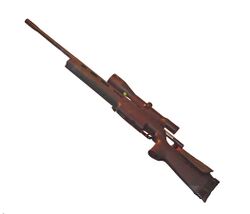

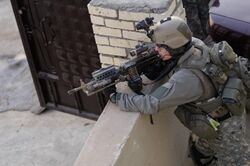
Rail systems usually are based on the handguard of a weapon and/or the Upper receiver. On modern pistols they are on the underside of the barrel. Rails on rifles usually start off at top dead center or 12 o'clock with the next placement at bottom 180° degrees or at 6 o'clock. on the forward section, away from the buttstock. With both sides 3 o'clock & 9 'o clock or 90° degrees each side of top center 0°/360° degrees becoming the 3rd & 4th most common. 1 o'clock or 11'o'clock is popular for the flashlight with a tape switch location placed on user preference. There may be additional attachment rails or holes at each 45 °degree angle position running partially or entirely the length of the handguard.
On the Kalashnikov rifles AK style/family the Warsaw rail is attached to the left side of the receiver when viewed from the rear . With more modern versions adding Picatinny style rails on to the sides of the handguards of the rifles for the mounting of addition equipment. Due to updating equipment, both styles may be found on some Warsaw Pact weapons.
Modern designed firearms often include rails made into the body, instead of being an added on modification. Older firearms may need permanent modifications of having holes drilled and tapped for screw threads to fasten the rail sections to the firearm. This is easier than milling out a dove tail slot for placement of a gun sight's parts.
Optics like scopes, reflex sights, holographic sights, red dot magnifiers, and night vision or thermal sights may be placed between the iron sights. Rail section may also come in various heights to help align equipment. Which may align with the original iron sights inline or below an illuminated optic's center dot, ring or chevron. This is referred to as Absolute or lower 1/3 Co-witness respectively. In addition to height variations some rail brackets may be offset at various degrees, 22.5°, 45°, and 90° are the most common, to place accessories and/or backup folding collapsible iron sights. So they are out of the line sight on the top of the firearm and/or to decrease the outer profile edge's size. Then the original sights are a backup if the electronic optic should fail. The rail section may also move a weapon-mounted lights forward so the flashlight (UK torch) does not shine and reflect back on the firearm directly. Creating shadows and visual impairment from this illumination.
The amount of rail space allows adjustment and personal optimization of each device and tool attached for the user. As designs have advance the amount of space has succeeded the actual need of placement space. Thus rail covers and protectors may be added, to prevent snagging on gear and/or plant foliage.
The six common types of rail systems for firearms are the Dovetail rail, Weaver rail, Warsaw Pact rail, Picatinny rail, KeyMod and M-LOK.
Future rails systems will have the option of carry power to supply the needs of the increasing electronics mounted to aid the shooter and/or soldier. Standards are still being determined for multiple countries. An example of such is NATO standards NATO Accessory Rail which is continued improvement and standardization of the Picatinny rail.
See also
- Rail Integration System (RIS)
- Dovetail rail
- Weaver rail
- Warsaw Pact rail
- Picatinny rail
- NATO Accessory Rail
- KeyMod
- M-LOK
- UIT rail
References
- ↑ Muramatsu, Kevin (14 July 2014). Gun Digest Guide to Maintaining & Accessorizing Firearms. Krause Publications. pp. 168–169. ISBN 978-1-4402-3989-2. https://books.google.com/books?id=eww5AwAAQBAJ&pg=PA169.
- ↑ Todd A. Kuhn (13 December 2013). Shooter's Bible Guide to Bowhunting. Skyhorse Publishing Company, Incorporated. pp. 289. ISBN 978-1-62873-404-1. https://books.google.com/books?id=WLzdxok3KcoC&pg=PT289.
- ↑ Picatinny, Weaver & dovetail scope bases
- ↑ Muramatsu, Kevin (16 June 2014). Gun Digest Guide to Maintaining & Accessorizing Firearms. Krause Publications. pp. 169–. ISBN 978-1-4402-3989-2. https://books.google.com/books?id=eww5AwAAQBAJ&dq=Picatinny%20rail%20schematic&pg=PA169.
- ↑ Inouye, Kevin (30 May 2014). The Theatrical Firearms Handbook. Taylor & Francis. pp. 364–. ISBN 978-1-317-85981-9. https://books.google.com/books?id=zBevAwAAQBAJ&pg=PT364.
- ↑ Sweeny, Patrick (30 August 2016). The Bench Manual Gunsmithing the AR-15. Gun Digest Books. pp. 284–. ISBN 978-1440246609. https://books.google.com/books?id=5RnMDAAAQBAJ&dq=Picatinny+rail&pg=PA115.
- ↑ Rros and Cons Picatinny Rail
- ↑ Slowik, Max. "New Open-Source KeyMod Universal Mounting System by Vltor". http://www.guns.com/2012/07/27/vltor-keymod-open-source-universal-mounting-system/. Retrieved 3 August 2015.
- ↑ Curtis, Rob. "VLTOR gives the keymod tdp to you". Militarytimes.com. Archived from the original on 2014-02-26. https://web.archive.org/web/20140226103456/http://blogs.militarytimes.com/gearscout/2012/07/25/vltor-gives-the-keymod-tdp-to-you/. Retrieved 2013-04-09.
- ↑ MLOK vs KeyMod 2016
- ↑ Magpul Industries - M-LOK DESCRIPTION AND FAQ DOCUMENT
- ↑ KeyMod vs. M-Lok: The Next AR Rail Standard by Chris Baker, November, 19, 2014
- ↑ KeyMod vs. M-LOK Modular Rail System Comparison, Presented by Caleb McGee, Naval Special Warfare Center Crane Division, 4 May 2017 full pdf on page
- ↑ M-LOK vs KeyMod comparison 2017
- ↑ 15.0 15.1 "Picatinny Rails, Weaver Rails, What’s The Difference?" Brownells

